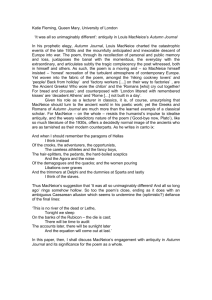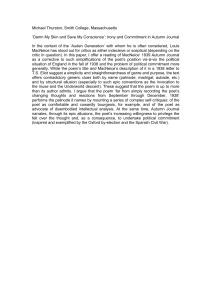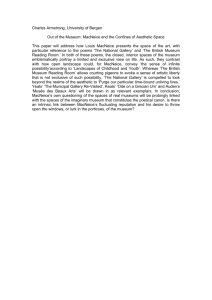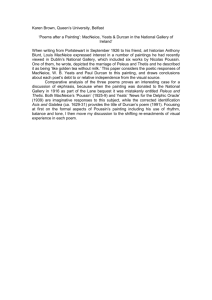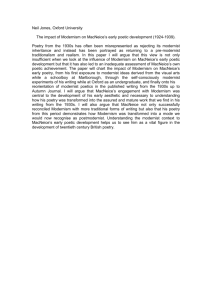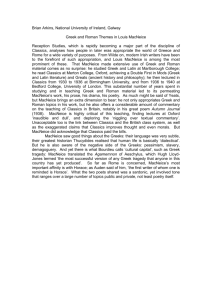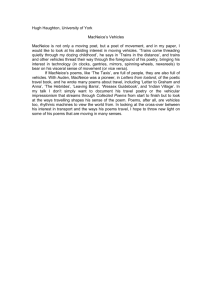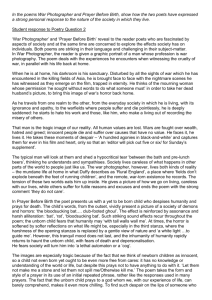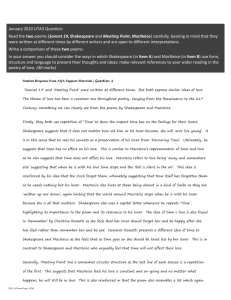Poetry Lecture 2012
advertisement
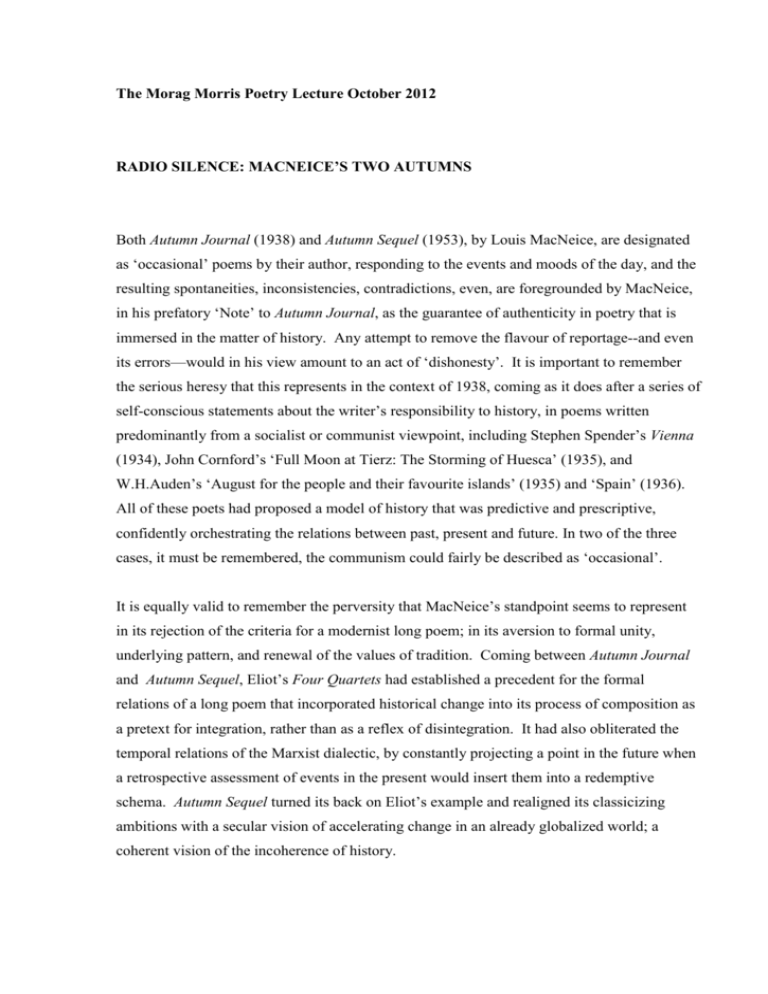
The Morag Morris Poetry Lecture October 2012 RADIO SILENCE: MACNEICE’S TWO AUTUMNS Both Autumn Journal (1938) and Autumn Sequel (1953), by Louis MacNeice, are designated as ‘occasional’ poems by their author, responding to the events and moods of the day, and the resulting spontaneities, inconsistencies, contradictions, even, are foregrounded by MacNeice, in his prefatory ‘Note’ to Autumn Journal, as the guarantee of authenticity in poetry that is immersed in the matter of history. Any attempt to remove the flavour of reportage--and even its errors—would in his view amount to an act of ‘dishonesty’. It is important to remember the serious heresy that this represents in the context of 1938, coming as it does after a series of self-conscious statements about the writer’s responsibility to history, in poems written predominantly from a socialist or communist viewpoint, including Stephen Spender’s Vienna (1934), John Cornford’s ‘Full Moon at Tierz: The Storming of Huesca’ (1935), and W.H.Auden’s ‘August for the people and their favourite islands’ (1935) and ‘Spain’ (1936). All of these poets had proposed a model of history that was predictive and prescriptive, confidently orchestrating the relations between past, present and future. In two of the three cases, it must be remembered, the communism could fairly be described as ‘occasional’. It is equally valid to remember the perversity that MacNeice’s standpoint seems to represent in its rejection of the criteria for a modernist long poem; in its aversion to formal unity, underlying pattern, and renewal of the values of tradition. Coming between Autumn Journal and Autumn Sequel, Eliot’s Four Quartets had established a precedent for the formal relations of a long poem that incorporated historical change into its process of composition as a pretext for integration, rather than as a reflex of disintegration. It had also obliterated the temporal relations of the Marxist dialectic, by constantly projecting a point in the future when a retrospective assessment of events in the present would insert them into a redemptive schema. Autumn Sequel turned its back on Eliot’s example and realigned its classicizing ambitions with a secular vision of accelerating change in an already globalized world; a coherent vision of the incoherence of history. The relationship between the two poems is itself problematic, and there may be less of a relationship than MacNeice wanted there to be. But their differences, especially of form and register, are precisely what implicate them in the historical circumstances they try to address, and their failure to conform to a model, even each other’s, is the guarantee of their authenticity in rendering the feel of living from day-to-day through two of the most complex episodes of the twentieth century. The first of these two episodes, the autumn of 1938, is better known, for obvious reasons, but the grand scale of the events as they unfold in MacNeice’s account is seldom allowed to overshadow the scale of events in the poet’s personal life, and it is this uneven relationship between the public and the personal that can now be seen as the only true measure of the movement of history, in which matters of state can never be extricated from the tangle of the everyday, the customary, the typical, in the syncopated rhythms of political and social history. From the perspective of political history, the central event of autumn 1938 is Chamberlain’s appointment with Hitler in Munich. Two days after he returns with the famous piece of paper, the Germans invade the Sudetenland. In the same week that Chamberlain flies to Munich for his pointless summit, MacNeice takes flight to Birmingham, and the two journeys are directly connected. In his unfinished autobiography, The Strings are False (1965), MacNeice explains that his impromptu visit to Birmingham is a reaction to the militarization of his own surroundings in north London, a reaction to the felling of trees on Primrose Hill by the Territorial Army: ‘The next morning Primrose Hill looked so forlorn that I took the train to Birmingham’ (p.174). But there is no escape in Birmingham, since ‘We spent the day listening to the radio.’ MacNeice’s immediate destination might have been anywhere, since everywhere in Europe is focused imaginatively on the meeting between Chamberlain and Hitler: ‘The faces in the street were just as lost as in London.’ Everywhere, it seems, is as distant from, and as close to, the obsession with Munich. While Chamberlain’s meeting is with Hitler, MacNeice’s equivalent encounter is with George Formby and Florrie Forde at the Birmingham Hippodrome. MacNeice notes that Formby’s ‘pawky Lancashire charm was just what we wanted’, but his reaction to Forde is more complex. The music hall artificiality of her performance offers a grotesque parallel to the pantomime of Munich, but the chief fascination with this somewhat alarming figure goes beyond ironic counterpointing: And Florrie Forde, now in her sixties, enormous, mammose, steatopygous, appeared each turn in a different dress, equally loud, equally bulging, a good sort essentially, once a chorus girl, once a principal boy, now with her voice gone still a music-hall sweetheart, sentimental as honeysuckle, vulgar as artificial violets, two hundred pounds of walking bonhomie and game to the last ounce of wobbling flesh. (pp.174-5) Forde is a fluid, unstable, protean figure; a vehicle for different costumes, different roles, different ages, different genders; she is both of pensionable age, ‘now in her sixties’, and ageless, resembling a prehistoric goddess figure, like the Willendorf Venus, ‘enormous, mammose, steatopygous’; she is both natural and artificial, endearing and alienating; above all, she is a bulging figure of excess, of an unpredictable energy that is uncontainable. MacNeice is both attracted and appalled by the spectacle she represents, just as he is mesmerized and horrified by the changes of direction, the promises and deceptions, the playacting, of Hitler himself. Forde represents a benign transformation all those figures of slippage, inconsistency and reversal that have begun to crowd in on MacNeice’s awareness from the world of political events, from the social and cultural spheres, from his private life, and from his own sense of self. In Autumn Journal, Hitler is epitomized as a ‘howling radio’ (p.114) but also as the agent of the constantly metamorphosing political events that are listed at the start of section VII; listed only to dissolve and give way to radical changes of function: Conferences, adjournments, ultimatums Flights in the air, castles in the air, The autopsy of treaties, dynamite under the bridges, The end of laissez faire. (p.113) Hitler’s screeching on the wireless is the counterpoint to the cutting down of trees, but the connection between the two is made initially by the speaker’s awareness of the insistence of unidentified noises, ‘dull blows’: Hitler yells on the wireless, The night is damp and still And I hear dull blows on wood outside my window; They are cutting down the trees on Primrose Hill. (p.113) The blatant threat on the airwaves is translated into the more obscure, but more immediate, threat of a hammering noise on the night air close by. The Territorial Army is clearing the trees in order to install anti-aircraft guns in their place, heavy artillery in place of recreation and the interactions of courting couples; the enjoyment of scenery, a leisurely ‘looking at the view’, is about to give way to the urgent probing of searchlights, scanning the skies ‘for bacilli / With narrow bands of blue.’ (p.113) The speaker of the poem tries desperately to revert to the innocence of yesterday, clinging to the imagery of mock-combat, of a ‘village tug-of-war’; a mere show of conflict that actually masks an old-fashioned sense of community. But in the midst of this amateurish destruction there comes the sudden realization that MacNeice’s dog has gone missing: And the rain came on as I watched the territorials Sawing and chopping and pulling on ropes like a team In a village tug-of war; and I found my dog had vanished And thought ‘This is the end of the old regime,’ But found the police had got her at St John’s Wood station And fetched her in the rain and went for a cup Of coffee to an all-night shelter and heard a taxi-driver Say ‘It turns me up When I see these soldiers in lorries’—rumble of tumbrils Drums in the trees Breaking the eardrums of the ravished dryads— It turns me up; a coffee, please. (p.114) MacNeice spent a considerable amount of his writing time in 1938 thinking about zoos and the domestication of animals, with a specific focus on the relationship between man and dog, characterized in the essay ‘Wild and Domestic’ as a Pygmalion-like relationship; man as sculptor whose creation is the object of his desire, a desire so powerful that it brings the object to life: ‘The dog, as we have domesticated hum, is in a sense our creation, a toy, an art object. We play Pygmalion with him and he comes to life.’1 MacNeice’s loss of his dog overlaps with the long-drawn out loss of his wife, an enduring absence that is reverted to with some frequency in Autumn Journal. His wife had gone off with another man, a desertion that MacNeice had experienced as a betrayal, but which he felt partly responsible for, his guilt mixed up with resentment. Losing his dog would sharpen a sense of negligence that preyed on him throughout this autumn. But just as the hysterical 1 ‘Wild and Domestic’, Selected Prose, ed. Alan Heuser (Oxford: The Clarendon Press, 1990) p.49 oratory of Hitler is made to seem strangely congruent with the felling of trees on Primrose Hill, so the loss of his dog is made almost symptomatic of large-scale historical surrender: and I found my dog had vanished And thought ‘This is the end of the old regime’ But found the police had got her… This is an almost jarring but characteristic sleight of hand, whereby the poem expands the scope of domestic details to make them fit into much more extensive contexts of implication. The need for change in MacNeice’s domestic economy, his failed attempts to manage both dog and wife, sponsors a figure of speech that might be taken literally, articulating a more general sense of impotence over the course that history has taken. The intervention of the police is both reassuring and admonitory, since the police both maintain order and bring malefactors to justice. If MacNeice is accusing himself of bad stewardship here he is also implying a shared culpability over recent events in Europe. Incidentally, one of Peter Macdonald’s most acute perceptions, in his book Louis MacNeice: the poet in his contexts (Oxford: The Clarendon Press, 1991), is that ‘The image of inaccessible femininity is important in the poem, pursued but never controlled’ (p.92) Having retrieved his dog, MacNeice specifies, revealingly, that he does not return home, choosing instead to stop for a coffee at an ‘all-night shelter’. The shelter is a staging-post, a point of transit in place and time, it represents a strategic form of homelessness, an incidental, seemingly casual, choice of a provisional location and condition which is nonetheless central to the poem’s manoeuvring around several different possibilities of where to belong, and who to belong to. In Joyce’s Ulysses, the visit to the cabman’s shelter represents the final stage of wandering before the return to 7, Eccles Street, its impermanent arrangements serving to underscore the value of the more enduring aspects of Bloom’s domestic regime. But in Autumn Journal, it represents only a point of momentary contact for MacNeice’s ricocheting sense of social, political and sexual identity. The syntax of this long sentence is wayward, revisionary, prone to sudden changes of direction, with perhaps the most dislocated of its successive observations being included within parenthetical dashes: --rumble of tumbrils Drums in the trees Breaking the eardrums of ravished dryads— This implies that the passing of the old regime incurs revolutionary terror and sexual violation, class punishment being confused, disturbingly, with vicious revenge for emotional betrayal, an inadmissible fantasy of control over the insubordinate female. The speaker is ‘turned up’ both by the felling of the trees and by his own worst imaginings of a woman he can never go home to again. His mind cannot rest on the revolution that has taken place in his own sense of home as domestic setting, set of cultural preferences, political status quo, any more than he can settle physically in the flat now assailed by the sound of falling trees and broadcast rhetoric, the cacophony of history out of control. This long, wandering sentence, beset with obstacles and distractions, is succeeded by a decisively organized and decisively focused description of one thing: repetitive mechanical action, the most undeviating alternative to human indecision, hesitancy, complexity of motive: And as I go out I see a windscreen-wiper In an empty car Wiping away like mad and I feel astounded That things have gone so far. (p.114) This image, so definitive for MacNeice, acts as a pivot, not only for section VII but in many ways for the poem as a whole. The automated wipers seem to have taken on a life of their own, while the speaker, responding simultaneously to the unnerving spectacle they present and to the realization that history has reached a point of no return, is himself turned to stone; the etymology of ‘astounded’ leads back to the Middle English ‘a-stoned’. This is the diametrical opposite of Pygmalion’s creativity, bringing inert matter to life; the self of 1938 has been metamorphosed into a condition of suppressed agency, thwarted desire and pointless routine: a machine-like existence that transfers the epithet ‘mad’ to the speaker’s own point of view. Machines play an important part in MacNeice’s thinking in 1938. Because they are manmade, they are linked to questions of responsibility and control; of proper management or of culpable, even criminal, negligence. They raise the spectre of an autonomous machine-driven world whose priorities are no longer those of humanity; one whose convenience, efficiency and power influences humanity into adapting itself to the priorities of the machine. The most recurrent image encapsulating this shift in priorities is that of the escalators on the London Underground, first registered ominously at the end of Section I: And so to London and down the ever-moving Stairs Where a warm wind blows the bodies of men together And blows apart their complexes and cares. (p.103) These lines introduce MacNeice’s deep distrust of a technology that not only symbolizes the de-individualizing of humanity but also plays an active part in bringing it about. The wind that appears to ignore the individuality of those it rushes around is sharply reminiscent of the endlessly scouring winds of Dante’s Inferno, a parallel that is underscored by the downward and seemingly perpetual motion of the escalators. The violent disintegration that is one scenario permitted by use of the phrase ‘blows apart’ evokes a physical correlative to the more gradual psychological process of self-abnegation, the dissolving of precise anxieties and affections—both kinds of ‘cares’—that ensure the uniqueness of every individual history of emotions. Our relationship with escalators is almost entirely passive. We are often placed in situations where we have no option but to use them, and we have no control over their direction or pace, and cannot stop them or start them at will. This is not the case with the car. It is revealing that MacNeice’s relentless windscreen wipers are demoralising precisely because they are attached to an empty car. The car is the prime example of a machine over which we have extensive control, although our self-confidence in that regard can be hubristic and selfdeluding. Section XIV of Autumn Journal aligns the control of machinery with participation in the political process. In fact, the car in this instance is employed directly in the political process, since MacNeice places himself at the disposal of canvassers for the Oxford byelection, offering to drive voters to the polls in order to stop the Conservative candidate, Quintin Hogg. The electoral arrangements are referred to briefly, but by far the greater part of section XIV is given over to an evocation of driving by night, both on the outward and the return journey, emphasising the risks and the temptation to recklessness: And coming over the Chilterns the dead leaves leap Charging the windscreen like a barrage of angry Birds as I take the steep Plunge to Henley or Hades. And at the curves of the road the telephone wires Shine like strands of silk and the hedge solicits My irresponsible tyres To an accident, to a bed in the wet grasses. (p.128) Although the avoidance of accident involves the exercise of skill and an element of luck, this passage shows the speaker almost flirting with danger—in his responsiveness to the hedge’s soliciting and the attraction of the bed it seems to guide him to—as well as proposing that much of what happens lies out of his control, depending on the agency of the aggressively leaping leaves, the shining telephone wires, the seductive hedge and the ‘irresponsible tyres’. The sheer frequency with which Autumn Journal is drawn towards the use of the transferred epithet underlines the critical importance of questions of responsibility, of the need to avoid passivity and establish the scope for self-determination. This scope includes the paradoxical option of self-destruction, which surfaces in the strange allure of a prospective accident and in the ‘plunge’ towards Hades, the enjambment between ‘steep’ and ‘plunge’ ensuring that this prospect is viewed almost with the relish of a diver. In section XIV, the windscreen-wipers seem to unleash an energy and aptitude beyond anything the speaker can come to terms with: the windscreen-wiper Kept at its job like a tiger in a cage or a cricket that sings All night through for nothing. The earlier reference to the manic action of the wipers ‘wiping away like mad’ is here intensified in the claustrophobic insanity of the zoo animal, and in the irrepressible action of singing for no purpose that humanity can grasp. The Pandora’s Box of mechanical systems, releasing a chain of consequences that humanity struggles to control, is at the centre of this poem’s own singing, which tries to come to terms with the experience of faltering and intermittent control over the systems of international and domestic politics, as well as the self’s relationships with time and place, and the people through whom these relationships are negotiated. The fascination with machinery embraces a range of more or less unsuccessful attempts to position and orientate the self in relation to the shifting coordinates of both public and private life, but the poem turns aside from humanity’s dysfunctional relationship with the products of its own ingenuity when it needs to plumb the depths of utter helplessness, expressing the futility of humanity’s efforts to manage its environment in a series of linked allusions to natural disasters. The most double-edged of these allusions occurs in section VII, the Munich section: But one—meaning I—is bored, am bored, the issue Involving principle but bound in fact To squander principle in panic and self-deception— Accessories after the act, So that all we foresee is rivers in spate sprouting With drowning hands And men like dead frogs floating till the rivers Lose themselves in the sands. (p.114) The last four lines quoted here seem to comprise a direct allusion to, and a direct countermanding of, the crucial exhortation of John Cornford’s 1936 poem, ‘Full Moon at Tierz: Before the Storming of Huesca’, which formulates the poet’s commitment to engagement in the making of history: Time present is a cataract whose force Breaks down the banks even at its source And history forming in our hand’s Not plasticene but roaring sands, Yet we must swing it to its final source. The same elements, of sands, rivers and hands are present in both poems in emphatic pronouncements about the movement of history. In Cornford’s poem, the forces of history are bewilderingly protean—water changing into sand—and yet the unswerving task of the communist is to guide and channel this volatile force. In MacNeice’s treatment, this force eludes capture, melts into the background, while the only hands in view are waving briefly before drowning. Both poems may in fact be following the lead set by Auden’s 1935 poem, ‘August for the people and their favourite islands’, which ends with the river of history undergoing a protean reversal into fire: And all sway forward on the dangerous flood Of history, that never sleeps or dies, And, held one moment, burns the hand. Rivers and hands again. Auden’s final line captures the ambivalence of the politically motivated writer, eager to make a difference, anxious to translate his writing into a form of action, but repulsed by history’s stubborn resistance to his own frames of reference, a resistance which Cornford’s inexorable rhythm and rhyme scheme override. MacNeice’s looser rhyme scheme and exploratory metre is more tentative, feeling its way towards disappointment, where the insistence on ‘fact’ and ‘act’ are succeeded by the yielding of ‘hands’ to ‘sands’. But the peculiar strength of MacNeice’s writing lies in the full measure it gives to exploration of the protean self that is caught up in the unnavigable flood of history. The individual ‘I’ has to define and re-define itself constantly against the general and stereotypical ‘one’, has to monitor and adjust its position within an inclusive ‘we’, and is committed to an ongoing revision of its relations with various avatars of ‘you’ and ‘them’. The pronominal flexibility of the writing self is more challenging and more giddying than in any other poetic project of the period, leaving aside the deliberately contrived transformations of subjectivity in the texts of the surrealists. Just as the writing seeks constantly to house and re-house the self within the range of pronouns, with the same ambition it conducts a review of the various houses—family homes and institutions—within which the speaker has been nurtured, educated or employed. None of these qualifies as a template that the others might fit; each contributes to the composition of a self that is many-sided, inconsistent, contradictory, a different self for every occasion, every setting, every relationship. ‘Home’ becomes multiple or evanescent, and the sum effect of the poem’s attempts to fix the successive positions of the biographical self is to accentuate the movement between these positions, the heightened awareness of being alive while in transit, between locations, between assignments, between significant moments of togetherness, between lovers. It might be partly owing to the sense of incompleteness that arises from MacNeice’s insistence on honesty, the vagaries and inner conflicts that emerge from a selfexamination that is resolutely occasional, that prompts him to devise a radically different conceptual scheme for the follow-up to Autumn Journal—Autumn Sequel, whose timing, fifteen years after publication of the earlier long poem, reflects the post-war experience of many for whom the relations between past, present and future have been dramatically reorganized, whether consciously or unconsciously. Autumn Sequel mostly averts its gaze from childhood homes, marriages and love affairs, (although not from schoolboy and student attachments) and reconfigures the self in relation to abiding friendships, long-term affiliations and obligations which form a continuing and strengthening background to the speaker’s more immediate, more intense, and more temporary, concerns. This gives the poem almost the character of a symposium in which the interlocutors remain involved irrespective of temporal or spatial dislocation, and indeed whether they are alive or dead. The public events of 1953—the coronation of Queen Elizabeth II, the conquest of Everest by Edmund Hillary and Sherpa Tensing—are ostensibly more unifying and celebratory in character than the public events of 1938; however, the longterm historical pressures that are monitored by the poem give it a sourness and a note of exasperation well formulated by Robyn Marsack in her book The Cave of Making: the Poetry of Louis MacNeice (Oxford: The Clarendon Press, 1982): ‘For MacNeice, who details in the poem the pressures working for disillusionment, conformity, anonymity, despair, who finds death coming prematurely to many, his friends are the bearers of value in his world’ (p.101). But as valuable as it is, the private sphere of friendship conjured up by the poem appears fragile and apt to elegiac treatment. One of the friends nominated in the first Canto, Dylan Thomas, dies in the course of the poem’s composition, and draws from MacNeice one of his most virtuosic prosopographical sketches. In Autumn Sequel, the constitutive division between public and private selves is deepened by MacNeice’s separate occupations of poet and radio scriptwriter, and this division is highlighted by MacNeice’s decision to compose his new long poem explicitly for radio transmission. The disjunction between the written and spoken dimensions of poetry could not have been underestimated by the author of Autumn Journal, with its deep suspicion of mass communications. And the distinct modes of writing required by poetry and the modern mass media, as well as the curious duplicity required to relate one to the other, is made clear in the strange double exposure of Canto III, which superimposes a vision of Everest onto an account of a rail journey to Beaconsfield. MacNeice travels on the commuter line through acres of standardized housing and past the antennae of Wembley Hill and Sudbury Hill, landmarks in what are referred to as the ‘drab realms of television’, a phrase hinting at his reluctance to perform the task of writing a script for Tom Stobart’s film about the climbing of Everest. The archaic meaning of ‘drab’ as a common prostitute gives an extra twist to his misgivings. Although the journey leads to a film studio where Stobart’s film is to be viewed, the transition from train to projecting room is occluded in the sudden juxtaposition of suburban back gardens and the Himalayan massif: We stop—and start. All Beaconsfield is gone, Each slick red wall and roof, each dapper row Of pompons and each deft automaton Trimming the lawns, all are submerged below The icefall tumbling from the Western Cwm Above which deserts of unsounded snow Brood, above which again one ominous plume Flies from the crest of what was Peak Fifteen Which even now knows fifteen brands of doom, Twenty-nine thousand and two feet high, a clean Rebuttal of the verities of Bucks Where a projector clamps it on a screen And I write words about it; gaps and rucks Are smoothed away, the silences of ice And solitudes of height washed out in flux, A weir of whirling celluloid. (pp.340-1). The central fact of this conception of Everest is its silence, ‘the silences of ice’, anticipated in the evocation of ‘deserts of unsounded snow’, snow that is both unplumbed, unfathomed, but also without sound. This seemingly unassailable silence can only be cheapened by the demands of scriptwriting, and MacNeice sounds an unmistakeable note of self-disgust in confessing that all he can produce in the face of Everest is mere verbiage. Words cannot match up to it, and yet the language of the poem, and particularly the movement of its language, enact a sense of exponential wonder in the gradual assimilation of the mountain’s grandeur. MacNeice’s description is in fact very close in spirit and content to Coleridge’s ‘Hymn before Sunrise, in the Vale of Chamouni’, used by Vaughan-Williams for the epigraph to the third movement of his Sinfonia Antarctica, given its first performance earlier in the same year, on 14 January 1953. Coleridge is describing the Alps, but his conceptual focus is identical: Ye ice falls! Ye that from the mountain’s brow Adown enormous ravines slope amain— Torrents, methinks, that heard a mighty voice, And stopped at once amid their maddest plunge! Motionless torrents! Silent cataracts! Coleridge is imagining a process that MacNeice’s scriptwriting can only reverse by breaking up the ice of silence, turning it into meltwater that can then be channelled, guided and distributed by management of the weir of whirling celluloid. This is not the wild river of history envisaged in the poetry of the 1930s, but a canalized suburban reality. Part of MacNeice’s interest in the extract from Coleridge’s poem is likely to be motivated by its use in Vaughan –Williams’s symphonic scheme, and in the circumstances of its composition. Vaughan-Williams’s music had taken initial shape as the incidental music to Charles Frend’s 1947 film Scott of the Antarctic, but had then been substantially reworked over several years into a more satisfying artistic whole. This major project of formal refinement might be regarded as a benchmark for MacNeice’s divided labour on the prose commentary for a commercially successful film and his poetic attempts to do justice to what the exigencies of film-making must omit. It is perhaps worth pausing on the contemptuous stress laid in this passage on the idea of ‘trimming’, which links suburban conformity with dishonesty in writing. ‘Trimming’ was the word employed in MacNeice’s prefatory ‘Note’ to Autumn Journal to refer to the charge of compromise that he clearly wished to forestall: ‘It is the nature of this poem to be neither final nor balanced. I have certain beliefs which, I hope, emerge in the course of it but which I have refused to abstract from their context. For this reason I shall probably be called a trimmer by some and a sentimental extremist by others.’ (p.101). In Autumn Sequel, MacNeice does not forestall the charge of compromise, but brings it down on his own head: What price Should we demand for turning what was rare Into a cheap couvade or proxy paradise, Just one more travelogue to make the groundlings stare? (p.341) His own expedition to Everest itemises a journey out of suburbia, and a return to its very heart, without ever having left it in the first place. A ‘cheap couvade’ is a double travesty, a meretricious simulation of the birthing process, at once echoing and degrading the ‘brooding’ condition of the snow that has not been sounded and which is therefore conscripted into a kind of virgin birth, a paradox that implies the unthinkable as the real challenge to language that Everest represents, its reality as a place that MacNeice’s film-script refers to prosaically as being ‘outside of human experience.’ The ‘cheap couvade’ is paired with the oxymoron of a ‘proxy paradise’, a corrupt imitation of innocence, a knowing simulation of a world before knowledge: of birth, of sex, and of history. The subsequent eleven verses of Canto III conceive of history as a form of paradise that resembles a circle of hell: an endless cycle of demeaning temptations that are inevitably yielded to. MacNeice’s own greatest temptation is to yield to a form of mechanical writing: The woodpecker, like a typist, taps away Relentlessly; the record must be kept Though the same larceny happen every day, The original and the final sin. (p.342) The relentless writing is only analogous to the action of the woodpecker; but like the transferred epithet, much greater weight is given to the vehicle than to the tenor, exposing the consciousness of shirked responsibility. Commercially motivated writing should be shunned as a form of larceny. Despite the fact that ‘occasional’ poetry, another form of writing ‘day by day’, offers the chance of a different kind of record, giving a sense of the context from which nothing significant has been abstracted, the following verses explain the practical and ethical consequences of writing for the market, implicating the writer in the procedures of cutting, pasting and staging—and thus of faking—the material that appears in the final edit: In coldest Bucks. Ice pinnacle and ravine Dare us to turn their terrors to a stunt And let the millions see what some few dozen have seen. Stopwatch and gum and scissors bear the brunt But in the prop room there are crampons too And windproofs and an ice axe; when you hunt On ice you had better do what ice-men do; The abominable snow queen keeps her code, Thinks of herself and never at all of you, So cut your steps with caution, a slow road Is better than a quick crevasse; our aim Is popularity, not palinode. And careful with those rushes. Who can blame The middleman for leaving some things out? What’s in a peak that is not in a name? Middlemen all, we labour like devout Lay brethren whom our Rule allows to talk, Not knowing what the silence is about. (p.342) Jon Stallworthy’s biography of MacNeice notes that the poet had informed his son of the telltale signs betraying the fact that some of the footage showing the climbers close to the summit had in fact been shot elsewhere, and he was concerned that his own writing should have been tailored correspondingly to suit the climate of ‘coldest Bucks’. The passing reference to the snow queen hovers over a particularly savage instance of self-doubt on MacNeice’s part. ‘Abominable snow queen’ is a close alternative to ‘abominable snow man’ of course, a legendary figure whose provenance is more securely Himalayan, but there are two reasons why MacNeice would have wanted to transplant Hans Christian Andersen’s character from Spitsbergen to Nepal; or rather, Beaconsfield. In the original fairy story, the Snow Queen lives where the snow bees are most numerous, and the association between snow and bees can be made equally directly in the story of Edmund Hillary, a beekeeper whose summer occupation features in the script that MacNeice wrote for The Conquest of Everest. But the second reason to feature the snow queen in his poem is more compelling, and that concerns her guardianship of the fragments of the troll-mirror, a silver screen that distorts reality, and whose shattered fragments have been dispersed over the earth, getting in people’s eyes, and altering their vision for ever. It is only by arranging the fragments into the letters that spell eternity, that Kai, the boy hero of the story, will be released from an eternity of misperception. The ubiquity of the fragments is correlative with the mass market ambitions of cinema, and with the premium this places on popularity: ‘our aim / Is popularity, not palinode.’ A palinode is a retraction, a recantation of an earlier poem, a previous ode. It is a word that is introduced early on in both Autumn Journal and Autumn Sequel. In the earlier poem, it appears in the opening section in the phrase, ‘Autumnal palinode’, which is given a line to itself and is clearly self-referential. Autumn Sequel is manifestly intended as a recantation of MacNeice’s involvement in the film industry, but it is also partly a recantation of Autumn Journal, and a serial recantation of itself, an ‘occasional’ poem that is contrary and revisionary, constantly swivelling in different directions and changing its terms of reference. Its cacophonous argument with itself, its insistence on carrying on several different conversations at once with a variety of friends, is in a curious way the most adequate response to the challenge of silence, and to knowing precisely ‘what the silence is about.’ If MacNeice’s poetry is predicated on the avoidance of ‘final verdicts’, fuelled by an awareness of the multiplicity of different ways in which thought and feeling might be formulated, and therefore reinvented, it is ultimately haunted by the silence remaining when all the different versions cancel one other out. Silence is a hard taskmaster for the poet, but an even more difficult employer for a poet who works in radio. Silence is the very antithesis of radio; or so it would seem. It is instructive to remember that in Humphrey Jennings’s 1942 film, Listen to Britain, the only sounds the audience is asked to listen to consist of ambient noise; in the section that features the sounds of radio, only fragments of announcements from a range of different stations are heard, constantly interrupting and cancelling each other out. If the wordplay and allusiveness of poetry make it polyvalent, there is an important sense in which radio is the more crowded medium. MacNeice was committed to his work in radio; was assiduous and versatile as each task demanded. But his ambivalence towards the medium is well attested, and in Autumn Sequel, he found a form that rivalled its ability to jump between stations, riding the intervals of silence, tuning in and out at will, his hand on the dial, hovering between antagonists, between languages, between popularity and palinode. Rod Mengham
